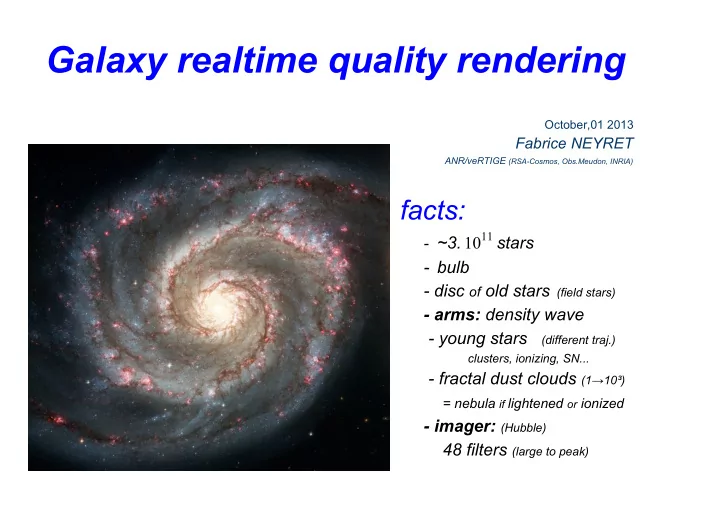

Galaxy realtime quality rendering October,01 2013 Fabrice NEYRET ANR/veRTIGE (RSA-Cosmos, Obs.Meudon, INRIA) facts: 1 11 - ~3. stars 0 - bulb - disc of old stars (field stars) - arms: density wave - young stars (different traj.) clusters, ionizing, SN... - fractal dust clouds (1→10³) = nebula if lightened or ionized - imager: (Hubble) 48 filters (large to peak)
List of requirements: (end: dec 2014) ●view from far ● view from inside ● continuous view from earth to nearby ● change imager filters ● animated galaxy ( using GALMER SPH simulation) ● amplify from astronomy statistics + ref images ●quality rendering ●strong realtime on highres skydomes (planetarium)
Some Challenges: ● mass of data (won’t fit memory & CPU) ○ astronomic objects ○ SPH simulation ( > 3x 10 ⁶ partics. NB: Still running ) ● all transparent (no star-star masking!) ● sub-scales count (appearance filtering) ● all spectral (sources, extinction, scatter, ionization, filter) ● non-linearities everywhere ● ranges of intensities + scales ● fusion of data ( amplified SPH + star catalog) ● continuum to discreet ● interpolations ● knowledge from different fields, to revisit, non-complete
Tools: ● GigaVoxels ( + for mass of data, LOD, transp, GPU) ● astro tables : ○ HR diagram : distrib P(L,T,Z,a) ○ iso-Padoue: distrib L,T,r(Z,a), ○ IMF, ICMF: distrib m stars resp/ clusters ● empirical eqn : ○ e xtinc (λ) , spectra (stars, scattering, ionization) ○ distrib Z,a,m(xyz) for star field layer ● SPH particles : ( ~30-40 blended ) ○ 3 layers : old stars field, gaz + young stars, black matter ○ M gaz , M stars , distrib(age,Z)
Addressing some challenges ● Spectral aspects ● non-linearities ( extinct( λ ,L) per se... ) ● interpolations ●Transparency vs optimizations ( pixel = star + dust mixture ) ● Filtering & LOD
1: Spectral aspects ●a priori knowledge 1 lin vs log vs log-log ; λ vs vs ; MKSA vs “column/Vsun” f λ ● filters known at run time → in filter window; proj on func base ○ peaks: separately, if needed ○ Filter weight: P 0 or P 1 ○ Source: ~ P 1 to P 3 cst − λ ; ~ P 1 or P 2 e ○ Extinction: → F.S.E : P n or P n . e − f (λ) ● store + render coefs ( not spectra ) ∫ ● easy λ
2: Filtering & LOD not 1 star, but: ● star mixture in pixels/voxels in facts, ● star + gaz extinct mixture ● “ “ + emissions mixture + inhomogeneous gaz ( so long ‘density’ ) ● “ “ “ ● “ “ “ “ + gaz-star correlation → Master 2013/2014 subject :-)
3: GigaVoxel framework ● high-level: octree of particles ○ phys data ○ 3 layers : gaz, clusters, stars (more compact + higher res) ○ produced from : Galmer’ CPU particles + filters ○ resident ● low-level: octree of voxel bricks ○ for rendering ○2 layers : “mixture color” + “cloud opacity” ○produced from : GPU particles + eqn(“2:filtering”) ○ transcient
Transparency vs optimizations ● Occlusion by dust: dark clouds are not iron walls stars intensity not in [0,255] so: never sure light won’t peak through ! → estimate before draw/load voxels: ● min-max Lum : RenderDetails(loc) iif trsp cur *L max (loc) > ε ε ● min-max Extinct : RenderDetails(loc) iif trsp cur *trsp (loc) > Δ ● stronger a priori knowledge ? ● Occlusion by stars: stars << pixel... but large disk of saturated pixels→ let’s use it ! 1 10 clamp( 0 . δ star * P SF captor * C ircleOfConfusion optic )
Interpolation and non-linearities find non-linear blending or reparameterize for X-lin vars ● B lending(spectra), extinction() , Π ● Voxel = MIPmaping = interp 4Dlinear (vars) ● SPH reconstruction = barycentric lin interp ● LODs ● fetch in maps (HR, spectra,…): lin or log or x ? then, integrals = MIPmapping
amplification and noise SPH simu: recons = smooth fields ● density continuum fluctuations ● continuum to discreet (clusters of clusters, clusters, stars) ● dust clouds ○fractal, on large range of scales ○features at all scales (cloud, arms, plumes...) ○anisotropy ○shaped by stars (shockwaves, ionization, SN)
hierarchical autogravity collaps → not fractal; multifractal → not Perlin- ∑ ; Perlin- : Π Π (1 + k . x) ) ) sBaseNoise( warp( 2 i
Eulerian Poisson noise: recursive top-down intervals
to be continued !
Recommend
More recommend